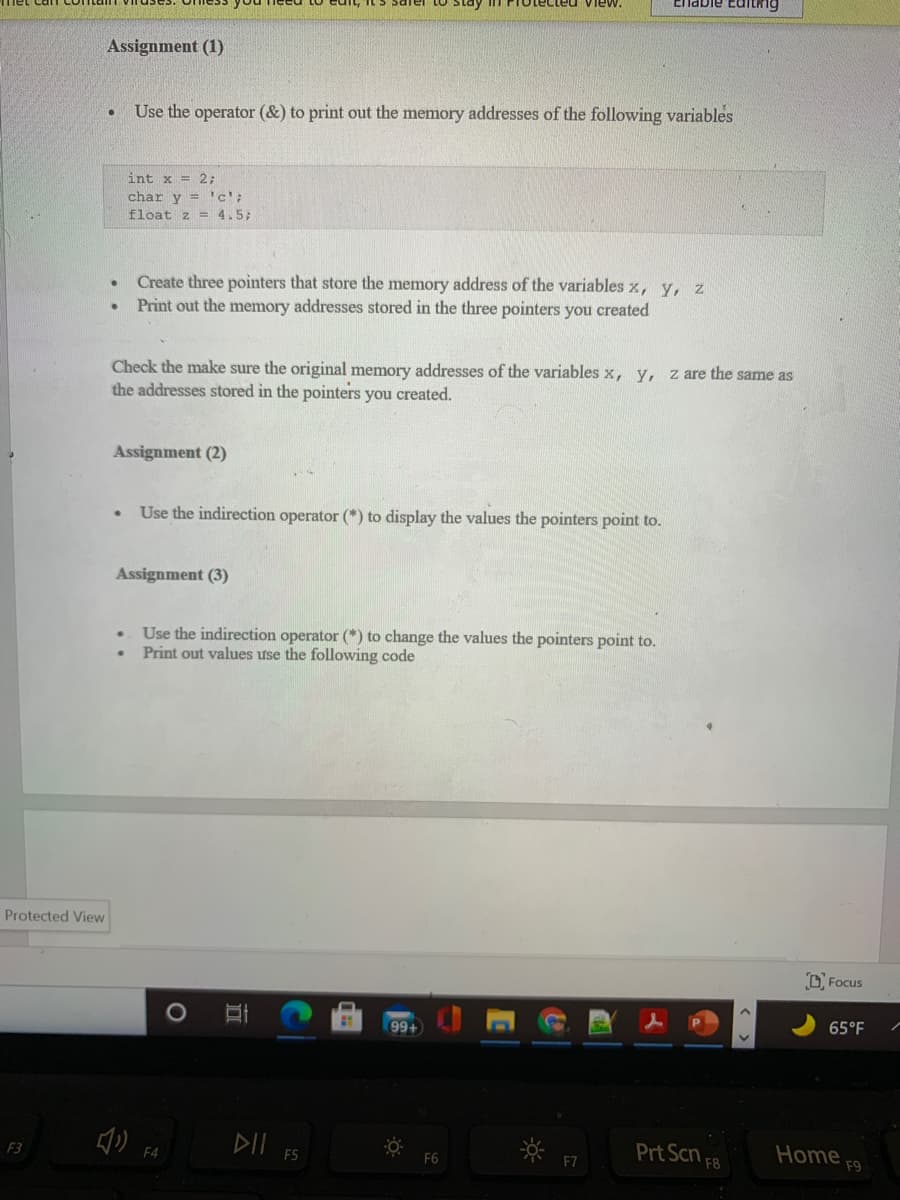Assignment (1) Use the operator (&) to print out the memory addresses of the following variables int x = 2; char y = 'c'; !i! float z = 4.5; Create three pointers that store the memory address of the variables x, y, z Print out the memory addresses stored in the three pointers you created Check the make sure the original memory addresses of the variables x, y, z are the same as the addresses stored in the pointers you created. Assignment (2) Use the indirection operator (*) to display the values the pointers point to. Assignment (3) Use the indirection operator (*) to change the values the pointers point to. Print out values use the following code
Assignment (1) Use the operator (&) to print out the memory addresses of the following variables int x = 2; char y = 'c'; !i! float z = 4.5; Create three pointers that store the memory address of the variables x, y, z Print out the memory addresses stored in the three pointers you created Check the make sure the original memory addresses of the variables x, y, z are the same as the addresses stored in the pointers you created. Assignment (2) Use the indirection operator (*) to display the values the pointers point to. Assignment (3) Use the indirection operator (*) to change the values the pointers point to. Print out values use the following code
C++ Programming: From Problem Analysis to Program Design
8th Edition
ISBN:9781337102087
Author:D. S. Malik
Publisher:D. S. Malik
Chapter12: Points, Classes, Virtual Functions And Abstract Classes
Section: Chapter Questions
Problem 23SA
Related questions
Question
100%
Code in C++ !! PLEASE USE COMMENTS FOR EACH LINE
CODE IN A IDE SO I CAN MAKE SURE IT WORKS

Transcribed Image Text:View.
Assignment (1)
Use the operator (&) to print out the memory addresses of the following variables
int x = 2;
char y ='c';
float z = 4.5;
Create three pointers that store the memory address of the variables x, y,z
Print out the memory addresses stored in the three pointers you created
Check the make sure the original memory addresses of the variables x, y, z are the same as
the addresses stored in the pointers you created.
Assignment (2)
Use the indirection operator (*) to display the values the pointers point to.
Assignment (3)
Use the indirection operator (*) to change the values the pointers point to.
Print out values use the following code
Protected View
D Focus
65°F
99+
) FA
DII FS
Prt Scn F8
Home
F9
F3
F6
Expert Solution
This question has been solved!
Explore an expertly crafted, step-by-step solution for a thorough understanding of key concepts.
This is a popular solution!
Trending now
This is a popular solution!
Step by step
Solved in 2 steps with 2 images

Knowledge Booster
Learn more about
Need a deep-dive on the concept behind this application? Look no further. Learn more about this topic, computer-science and related others by exploring similar questions and additional content below.Recommended textbooks for you

C++ Programming: From Problem Analysis to Program…
Computer Science
ISBN:
9781337102087
Author:
D. S. Malik
Publisher:
Cengage Learning

C++ for Engineers and Scientists
Computer Science
ISBN:
9781133187844
Author:
Bronson, Gary J.
Publisher:
Course Technology Ptr

C++ Programming: From Problem Analysis to Program…
Computer Science
ISBN:
9781337102087
Author:
D. S. Malik
Publisher:
Cengage Learning

C++ for Engineers and Scientists
Computer Science
ISBN:
9781133187844
Author:
Bronson, Gary J.
Publisher:
Course Technology Ptr